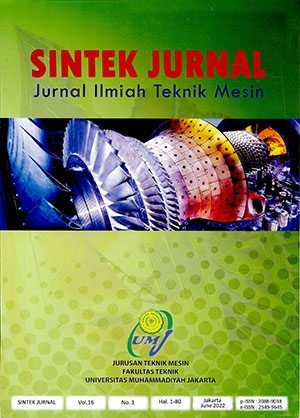Wear resistance of abradable-conductive powder deposited by using hvof with different surface preparation and spray distance
Main Article Content
Abstract
Article Details
- Articles published in SINTEK JURNAL are licensed under a Creative Commons Attribution-ShareAlike 4.0 International license. You are free to copy, transform, or redistribute articles for any lawful purpose in any medium, provided you give appropriate credit to the original author(s) and SINTEK JURNAL, link to the license, indicate if changes were made, and redistribute any derivative work under the same license.
- Copyright on articles is retained by the respective author(s), without restrictions. A non-exclusive license is granted to SINTEK JURNAL to publish the article and identify itself as its original publisher, along with the commercial right to include the article in a hardcopy issue for sale to libraries and individuals.
- By publishing in SINTEK JURNAL, authors grant any third party the right to use their article to the extent provided by the Creative Commons Attribution-ShareAlike 4.0 International license.
References
De la Fuente D, Díaz I, Simancas J, Chico B, Morcillo M. Long-term atmospheric corrosion of mild steel. Corrosion Science. 2011;53(2):604-17.
Pei X, Pu W, Zhang Y, Huang L. Surface topography and friction coefficient evolution during sliding wear in a mixed lubricated rolling-sliding contact. Tribology International. 2019;137:303-12.
Lima C, Guilemany J. Adhesion improvements of thermal barrier coatings with HVOF thermally sprayed bond coats. Surface and Coatings Technology. 2007;201(8):4694-701.
Pukasiewicz A, De Boer H, Sucharski G, Vaz R, Procopiak L. The influence of HVOF spraying parameters on the microstructure, residual stress and cavitation resistance of FeMnCrSi coatings. Surface and Coatings Technology. 2017;327:158-66.
Zoei MS, Sadeghi MH, Salehi M. Effect of grinding parameters on the wear resistance and residual stress of HVOF-deposited WC–10Co–4Cr coating. Surface and Coatings Technology. 2016;307:886-91.
Zhang B, Marshall M. Investigating material removal mechanism of Al-Si base abradable coating in labyrinth seal system. Wear. 2019;426:239-49.
Peng Y, Zhang C, Zhou H, Liu L. On the bonding strength in thermally sprayed Fe-based amorphous coatings. Surface and Coatings Technology. 2013;218:17-22.
Gawne D. Splat morphology and adhesion of thermally sprayed coatings. Proc of ITSC'95. 1995;2:779-84.
García-Rodríguez S, Torres B, López A, Otero E, Rams J. Characterization and mechanical properties of stainless steel coatings deposited by HVOF on ZE41 magnesium alloy. Surface and Coatings Technology. 2019;359:73-84.
Picas J, Punset M, Baile MT, Martín E, Forn A. Effect of oxygen/fuel ratio on the in-flight particle parameters and properties of HVOF WC-CoCr coatings. Surface and Coatings Technology. 2011;205:S364-S8.
Siu JH, Li LK. An investigation of the effect of surface roughness and coating thickness on the friction and wear behaviour of a commercial MoS2–metal coating on AISI 400C steel. Wear. 2000;237(2):283-7.
Zamani P, Valefi Z, Mirjani M. Effect of grinding and lubricating post-treatment on wear performance of plasma sprayed Cr2O3–Al2O3 composite coatings. Surfaces and Interfaces. 2019;16:206-14.


